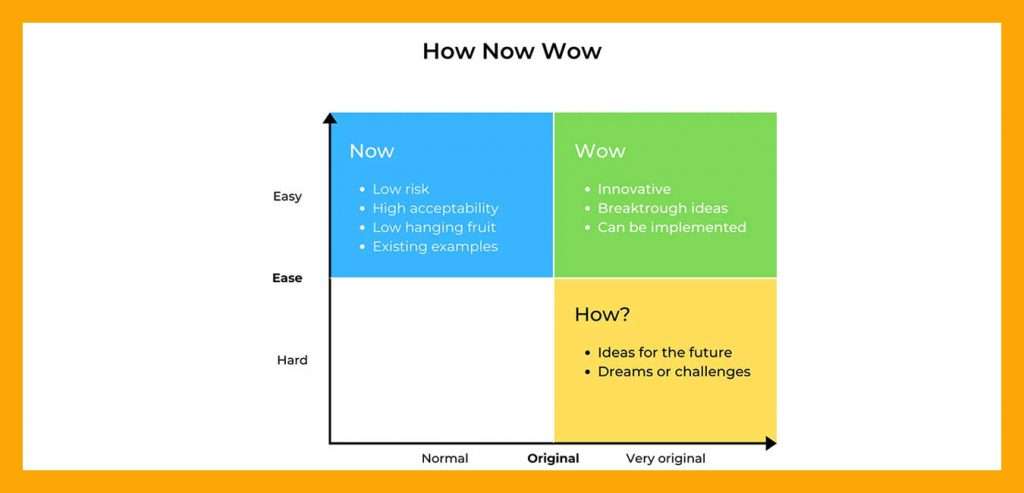Brainstorming is usually done when there is a problem, or you are trying to prevent one. For example, say a product needs an improvement, or you want to ensure people can’t hack your app. There is one common theme in all cases where there is a need to brainstorm—the goal of finding a workable idea.
When people talk about brainstorming, they think of ways to create eureka moments and quickly have a bulletproof idea. But it’s never so. It is critical to have an easy workflow so you can maximise the brainstorming session.
One of the problems with brainstorming is that people do it poorly. And they don’t even realise it enough to want to improve. Of course, their results accomplish their goals, but there’s still so much left on the table with a poorly done brainstorming session.
So how can you effectively brainstorm? How can you ensure everyone involved in the brainstorming leaves a valuable print? Whether it’s just you or your team having a brainstorming session, the pathway outlined here will help you achieve your goals in no time.
The first point to unlearn is that brainstorming starts when everyone involved is seated in the selected area for ideas generation. The information to relearn in place of this is that brainstorming has three stages.
- Before the brainstorm
- During the brainstorm
- After the brainstorm
Rather than introduce a new concept here, let’s keep the popular view of a brainstorming session while segregating it into achievable parts.
Before The Brainstorming Session

This process is crucial as it forms the bedrock of the whole ideation process. The before stage involves:
- Identifying the problem statement and goal
- Setting restrictions, if needed to the kind of idea generated
- Informing attendees well in advance of the first two bullet points
We all want to think outside the box and create novel and innovative ideas. But this does nothing if the goal of the brainstorming session is not accomplished. In fact, it wastes time, energy and ideas. So the first thing to do is identify the problem or goal of the session.
Depending on the situation, this might involve more than one person, but key participants should do this. Next, you want to set restrictions. If there are ideas that didn’t work before, technology that is not available, or a feature that must always be present, note them. Outline all non-negotiables.
Afterwards, inform all the individuals or teams involved in the brainstorming session. You want them to be able to sit on it. Procrastination can increase creativity by 40%. You can harness the increase by letting participants know but not requiring them to put down their ideas immediately. That way, they are “procrastinating” and building their creative juices for the brainstorming session.
Unless you’re incredibly short on time, let them know at least 24 hours before. If you have ample time, however, three days is enough. You want the team to refrain from resting on their haunches so much that it stunts their productivity. Even if this information is ready weeks or months before the brainstorming, be sure to remind them, so they go through it again.
During The Brainstorming Session

This is where most people think the bulk of a brainstorming session is. However, to know how to brainstorm effectively, you (and your team) must take important steps at this stage. Before any techniques are used, ground rules must be made for everyone involved.
- Ideas cannot be criticised
- Quantity over quality
- Encourage crazy ideas
- Build on each others’ ideas
- Document them all
It’s better that ideas flood the environment than to have a stall in the idea generation. The fifth technique below shows how to collect them all. You don’t want to be overwhelmed by the sheer number of suggestions, nor do you want to lose what could be a genius addition because you focused on one idea and left the others to rot. The team might want two, and if you end up with 30, that’s fine. You’d learn how to prioritise ideas from a brainstorming session further in the article.
Once all of these are set, the team can use the techniques below to boost the outcome of this brainstorming stage.
Hosting An Effective Brainstorming Session

It takes a lot of work to know how to brainstorm. But with these proven steps, any team is well on their way to genius ideas.
1. Break The Ice
Ideas don’t form simply because you told them to. It’s even harder to think when you are tense. So whether the brainstorming session is solo or in a team, find a way to ease the tension. You can even play some games that, over time, would help boost their creativity aiding in more effective brainstorming.
2. Do A Brain Dump
Before everyone starts talking over each other and possibly influencing ideas, set at most 5 minutes for everyone to write their thoughts, suggestions and ideas. Remember, in the pre-brainstorming stage, all participants were aware of what they needed to know. Even better, they can bring it written with them. Don’t try to edit the ideas at this stage.
With capable professionals on the team, this should be a smooth step. Then collect all ideas and collate them in a folder or sheet, depending on where you’re working from. These suggestions can either be anonymous or not.
3. Generate More Ideas
You want to make sure you’ve covered as much area as possible. I’ll highlight three of my favourite brainstorming techniques.
- S.C.A.M.P.E.R.
This method improves brainstorming from multiple perspectives. Visualise each of these bullet points as you go.
Substitute: What will substituting an element in an idea for another do?
Combine: What will combining two unique elements do?
Adapt: Can this idea be adapted to a different solution? How?
Modify: What can you change to make this solution stronger?
Put to another use: How can these ideas be used in another way?
Reverse: How can the idea be reorganised to make it more effective?
- 9 Whys
This is a popular technique for copywriters to find their ideal audience’s pain point, and it can be used here too. It basically entails asking why a problem came up. Once that is answered, ask a why to the answer. Keep asking why (about nine times) till you get to the bedrock of the problem. Identifying the fundamental problem makes it easier to come up with a solution.
- Rapid Ideation
Tasks expand to fit the time allotted to them. Here, there is a time limit to create ideas. This doesn’t translate to not creating ideas in quantity. Instead, it ensures you put down all your ideas as fast as possible without trying to flesh them out.
4. Build On The Idea
Once you’ve generated ideas in this brainstorming session, you want to strengthen them. While you might have good ideas from the onset, you can get better if you merge the strengths of two or more different ideas. Remember you have a goal, so as you keep building, refer back to it to ensure that all your suggestions are in line. This might seem like the pruning stage, but it’s not.
As far as the ideas fit in with the restrictions you’ve placed in the pre-brainstorming session, build on them, even if they seem crazy. You want to get as many top ideas as possible.
However, no idea should be discarded. They can be sorted differently based on their use now and use in the future. Even the seemingly unusable ones should be documented so that you are aware of what you’ve tried in the past. Build up on these ideas until you’ve gone through them all.
At least, you should have five robust solutions if you are trying to solve a problem or five credible innovations if you are trying to improve on something. Then, if you still need more, go back to number 3 and generate some ideas.
You want to prioritise now that the idea-dumping stage of brainstorming sessions is over.
Post Brainstorming Session

Unless you have a lot of free finances and/or time, you would not be able to build upon five different ideas to choose from ideally. After coming up with so many ideas and tightening them, there is a need to prioritise the options on the table. Again, the structures you’ve created in the first stage come into play here.
Keep them in mind as you use any brainstorming techniques below to pick a great idea.
1. How Now Wow Matrix
This technique is critical when you need to take action soon. You may have a great solution in your hands, but it takes more work to accomplish at this time. So you need time to figure out How to do it. A solution that can easily be implemented Now could be present, but they don’t have a unique selling point. The ideas that make you go Wow will be implementable in the real and present world.
Now: Easy to do, low risk, not unique
Wow: Creative, can be done, breakthrough**
How: Very innovative, struggles with accomplishing it in an ideal period

Ideally, you should pick ideas in the Now section and work on the How ideas (if applicable) for the future. That way, the team can use all the great ideas from the brainstorming session.
2. MoSCoW
This stands for:
Must have: Your non-negotiables
Should have: Important to have.
Could have: Very nice to have, but it’s not crucial
Would have: This is for the future versions
This technique prioritises your non-negotiables as should be. And it cuts out all the fluff, if any, in the idea(s). With this brainstorming technique, you can identify the basic framework for your best ideas.
3. I.C.E./P.I.E.
They stand for essential elements that ideas should have. They are popular frameworks.
I.C.E.:
– Impact: what impact would it have if it worked?
– Confidence: what level of confidence does the team (or you) have that the idea will work?
– Ease: how easy is it to do?
P.I.E.:
– Potential: what’s the potential of this idea concerning our goal?
– Importance: how important is the idea in achieving the goal?
– Ease: how easy is it to accomplish?
If the ideas have positive outcomes, then you want to pick that. Answer all of these brainstorming techniques honestly to give you the best results.
Again, document the ideas that don’t pass this stage of the brainstorming session for future reference. Then, if an idea still needs to be settled on, the participants can give a vote to pick which idea would be implemented.
Conclusion
Brainstorming is an investment that would pay off really well if done right. Using all the methods outlined in this article would ensure that nothing is left on the table regarding idea generation. And you can end the brainstorming session confident that you (and the team) got the most out of it.








